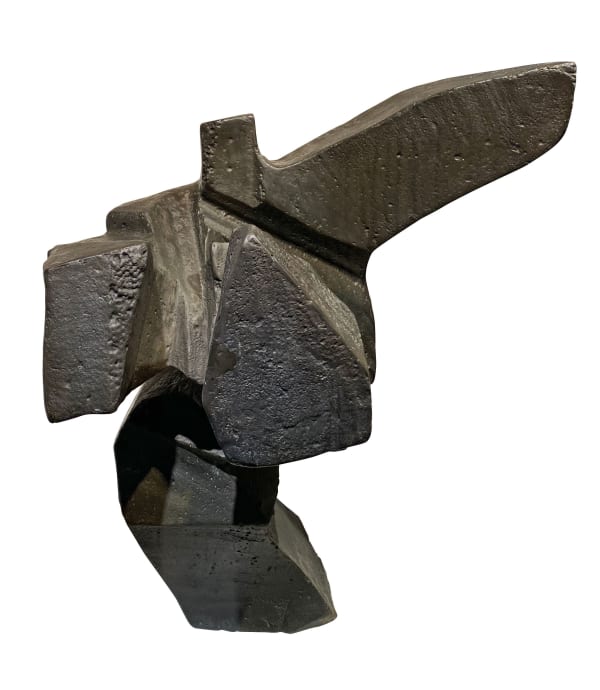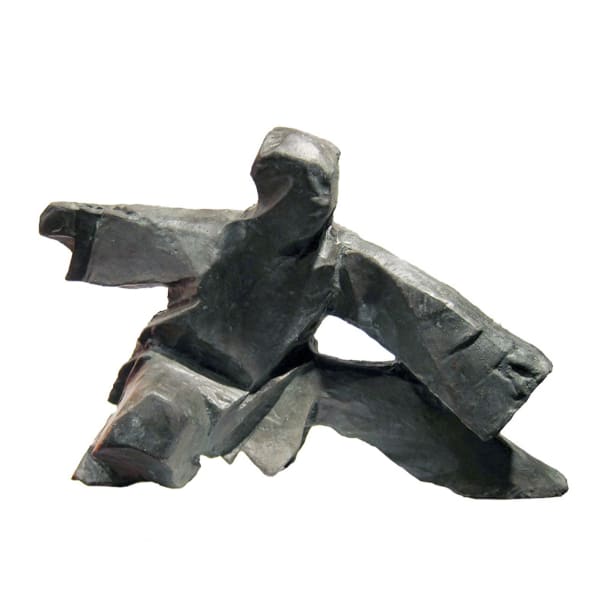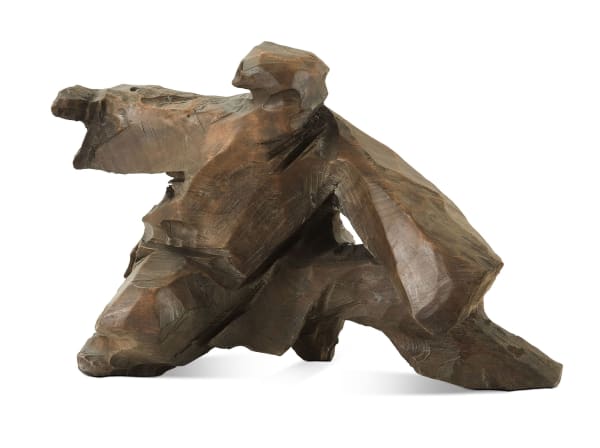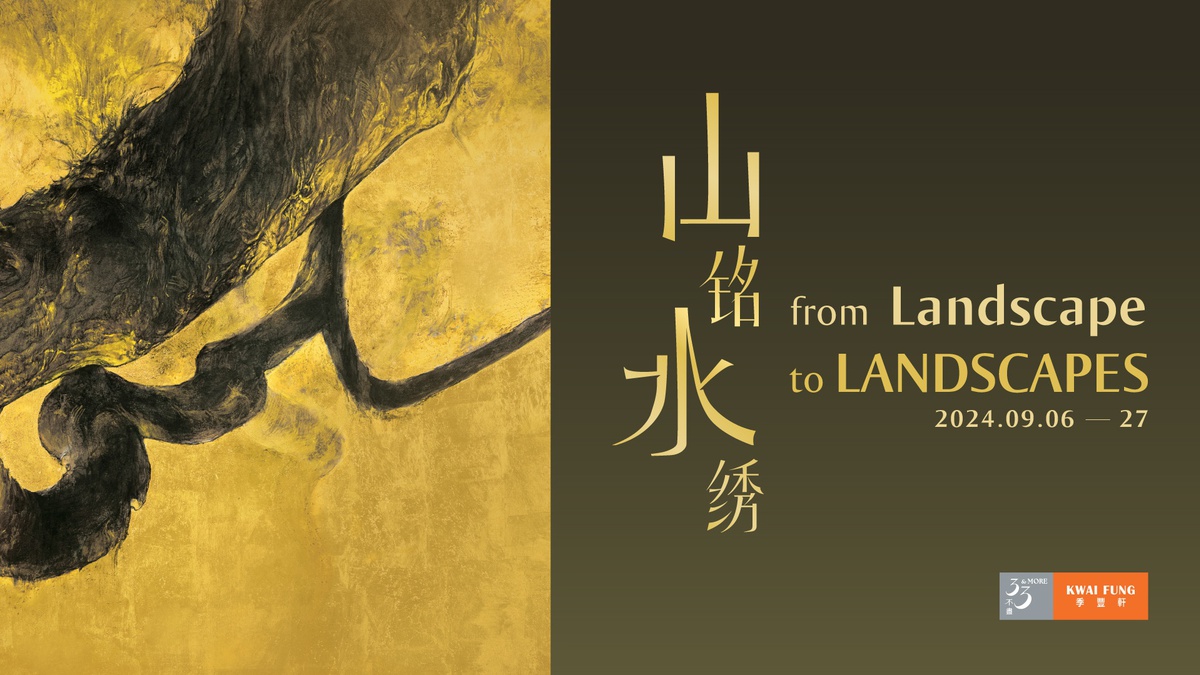Ju Ming 朱 銘 1938-2023
Ju Ming was born in 1938 in Maioli, Taiwan. At the age of 15, he studied wood carving and worked on restorations of the Mazu temple as an apprentice of Master Chin-Chuan Lee who was a Buddhist statuary craftsman. Later, when Ju was 30 years old, he studied under the tutelage of Taiwan's most eminent Modernist sculptor Yuyu Yang. At the same time, Ju started to create large-scale abstract works and explored new mediums including copper, iron, stone, stainless steel, sponge and ceramic.
In 1976, the National Museum of History in Taipei held Ju Ming's first solo exhibition. After receiving much acclaim for his sculptures, Ju was named as one of the Ten Outstanding Youths of 1976. Despite the exhibition's unprecedented success, Ju was not fully satisfied with his work. At the time, Ju developed a daily practice in Taichi boxing for his health. He grew inspired by the art of Taichi and gradually developed his Taichi series to convey the practice's dynamic movement into his carvings. Ju's Taichi realizations and particular use of medium not only supported his personal development and artistry, but also distinguished him from his peers.
In 1977, Ju Ming had his first show outside of Taiwan at the Tokyo Central Art Museum in Japan. The exhibition showcased 28 of Ju's Taichi series's wooden sculptures and won high praise from Japanese critics. From 1980 onwards, Ju continually gained international acclaim and exhibited his works abroad.
During the 1980s and 1990s, Ju Ming's artistic creativity came to full fruition. His major productions, Taichi series and Living World series, developed during this time and he continues to expand both breadths of work.
Ju Ming has received various awards and recognitions for his talent. In 2003, he was given a title and diploma as an honorary Doctor of Art by Fu Jen Catholic University. In 2004, Taiwan's Executive Yuan honoured Ju Ming with the Cultural Award, which is considered the highest honour and prize in the arts and cultural circles of Taiwan. In 2007, Ju was awarded the 18th Fukuoka Asian Culture Prize, following a long list of honors.
-
 Taichi Series (太極系列)
Taichi Series (太極系列) -
 Taichi Series : Single Whip (太極系列 : 單鞭下勢)
Taichi Series : Single Whip (太極系列 : 單鞭下勢) -
 Taichi Series (太極系列)
Taichi Series (太極系列) -
 Taichi
Taichi -
 Single Whip (單鞭下勢), 1966
Single Whip (單鞭下勢), 1966 -
 Taichi Series - Single Whip《太極系列—單鞭下勢》, 1976
Taichi Series - Single Whip《太極系列—單鞭下勢》, 1976 -
 Taichi (十字手), 1981
Taichi (十字手), 1981 -
 Taichi Series (太極系列-飛踢), 1984
Taichi Series (太極系列-飛踢), 1984 -
 Taichi Series : Single Whip (太極系列 : 單鞭下勢), 1985
Taichi Series : Single Whip (太極系列 : 單鞭下勢), 1985 -
 Taichi Series (太極系列), 1990
Taichi Series (太極系列), 1990 -
 Taichi Series (太極系列), 1991
Taichi Series (太極系列), 1991 -
 Taichi Series (太極系列), 1991
Taichi Series (太極系列), 1991 -
 Taichi Series - Turn Stomp 《太極系列 - 轉身蹬腿)》, 1992
Taichi Series - Turn Stomp 《太極系列 - 轉身蹬腿)》, 1992 -
 Taichi Series 《太極系列 - 起勢》, 1992
Taichi Series 《太極系列 - 起勢》, 1992 -
 Taichi Series - Shadow Boxing (太極系列 - 對招), 1994
Taichi Series - Shadow Boxing (太極系列 - 對招), 1994 -
 Taichi Series (太極系列), 1995
Taichi Series (太極系列), 1995 -
 Taichi (太極) , 1995
Taichi (太極) , 1995 -
 Taichi Series (太極系列), 1995
Taichi Series (太極系列), 1995 -
 Taichi Series (太極系列), 1995
Taichi Series (太極系列), 1995 -
 Taichi (太極), 1995
Taichi (太極), 1995 -
 Taichi Series (太極系列), 1995
Taichi Series (太極系列), 1995 -
 Single Whip, 1995
Single Whip, 1995 -
 Taichi Series《太極系列 》, 1995
Taichi Series《太極系列 》, 1995 -
 Taichi Series - Turn Stomp《太極系列 - 轉身蹬腿》, 1998
Taichi Series - Turn Stomp《太極系列 - 轉身蹬腿》, 1998 -
 Taichi Shadow Boxing, 1998
Taichi Shadow Boxing, 1998 -
 Taichi Series : Single Whip (太極系列 : 單鞭下勢, 1998
Taichi Series : Single Whip (太極系列 : 單鞭下勢, 1998 -
 Taichi Series - Taichi Arch《太極系列 - 太極拱門》, 2000
Taichi Series - Taichi Arch《太極系列 - 太極拱門》, 2000 -
 Taichi - Single Whip (太極 - 單鞭下勢), 2003
Taichi - Single Whip (太極 - 單鞭下勢), 2003
TAICHI SERIES
From its inception, Ju Ming's Taichi series developed in the spirit of Chinese martial arts. Using wood, bronze and stainless steel as medium, Ju composes sculptures with large surfaces and imbalanced shapes to illustrate a powerful bow or kick from Taichi. His early Taichi works draw heavily on the art's boxing forms but overtime, they have gradually drawn away from focusing on "form" to convey the "idea" of Taichi and offer a deeper spiritual and artistic experience. Ju Ming shared, "It's not just carving this form or that form, but [carving] the changes between forms." This statement surprised many Taichi teachers who challenged: "This form is familiar. Why haven't I seen it in pictures?" In response, Ju Ming explained that his Taichi creations mold "similar in appearance" and "similar in spirit", from the visible to the invisible.
LIVING WORLD SERIES
Ju Ming's Living World series was inspired by New York's vibracy, which translated into his colored wood sculptures. Ju creates with heart and makes change in his artistry when he is moved by new inspiration and experience. Ju Ming remarked,
"Why did I carve Living World? I thought I should carve something about life. The Living World series is inspired from life, and the attitude behind its production is close to a modern concept of sculpture as well, which is founded on an easygoing and free spirit."
Since the integration of this series in his portfolio, Ju Ming's works have gone through many transformations. He has expanded the medium he works with to include potter's clay, sponge, bronze and stainless steel. His wide array of subjects have included animals, middle-aged women, modern girls, athletes, monks, and more.
The strong Taichi series and the soft Living World series represent two sides of yin and yang. Ju Ming merges the essences of Chinese culture into his craftsmanship that his sculptures elude a unique and impressive power and spirit.





























